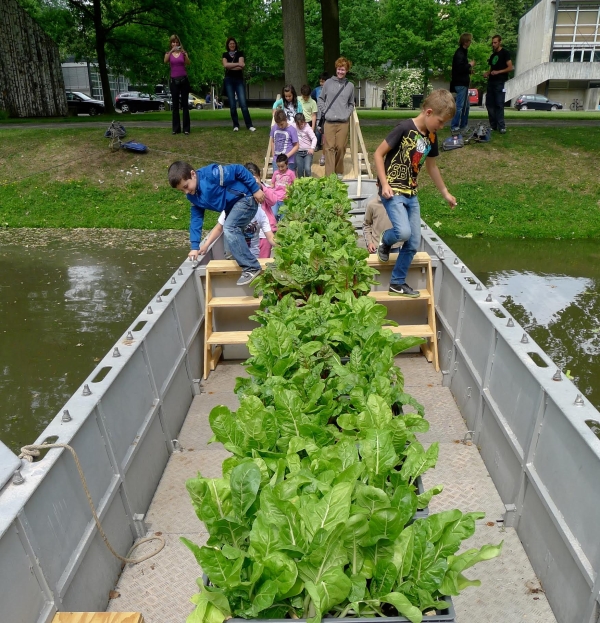Swiss Chard Ferry
<strong style=\"text-align: justify\">In: dOCUMENTA (13)
9 June – 9 September 2012
Kassel<strong style=\"text-align: justify\">, Germany
© Christian Philipp Mueller for dOCUMENTA (13), Kassel, 2012
For “Swiss Chard Ferry, The Russians aren’t going to make it across the Fulda River any more” Müller planted 60 varieties of colorful chard (Beta vulgaris), collected with the help of David Kottis, from various seed-banks worldwide. The plants were placed on six barges in 66 crates, of which 60 contained single varieties and six a mix of Swiss chard from Switzerland, Turkey, Cuba, Israel, China and India, among other places.
The barges are units made of standard pontoons, dating from the Cold War and lent for the 100 days of d13 from the THW (Technischer Hilfs-Dienst), the official Federal German Technical Relief Organization for Water Hazards. The vernacular aesthetic referred to post-disaster devices as well as to the boat that ferried visitors to nearby Siebenbergen Island until the mid 1950s.
“Swiss Chard Ferry” was a metaphorical bridge between different realms — and formed a temporary shortcut between pedagogy and pleasure — between the School for Art and Design Kassel and the Historic Pleasure Garden Karlsaue, dating from the 17th century. The hybrid mobile sculpture combined minimal high-technology with a colorful array of edible vegetables realized in collaboration with the Department of Organic Agricultural Sciences of the University of Kassel in Witzenhausen.
The project also involved the participation of visitors who were invited to taste the chard and explore the connections between names like “Pot of Gold” and “Pink Lipstick” and their country of origin.
The temporary bridge became a ferry three times during the Preview of d13 and during the tasting-events on July 28 and September 15 which were positioned adjacent to the ferry.
“Swiss Chard Ferry Tasting” was the activation of Christian Philipp Müller’s project for dOCUMENTA (13) which consisted of turning six barges from the Cold War into floating Swiss chard gardens. By means of the sixty different varieties of Swiss chard grown on them, the ferries were given a new life, bringing forth a historical, environmental, and culinary narrative. During two chard-tasting experiences on July 28th and September 15th, 2012, over 700 visitors attended. Twenty of the sixty varieties of chard were lightly sautéed to be tasted on their own and ten international recipes featuring chard were also presented. Members of the Agricultural Department of the University of Kassel gave a presentation on biodiversity, and Müller discussed the historical and artistic dimensions of his project.


